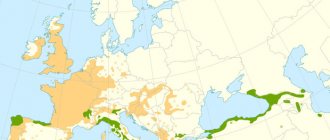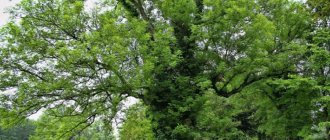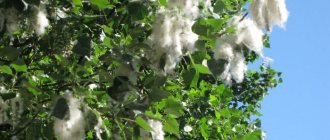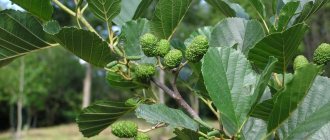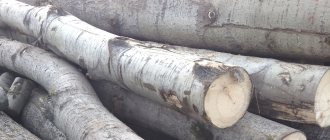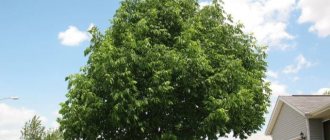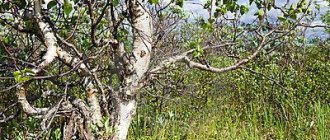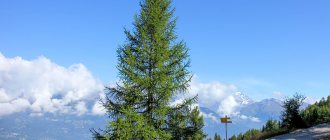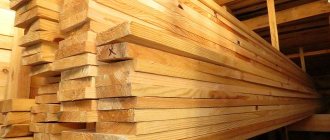I advise lovers of beauty and a healthy lifestyle to pay attention to chestnut.
Chestnut is a wonderful decorator of our gardens and an excellent healer for our souls and bodies. Why do I say this? Yes, because 15 minutes spent under a chestnut tree can energize you for the whole day, and its fruits are extremely beneficial for health. The tasty nuts of edible chestnut species are used to prepare many different dishes, and the inedible fruits of horse chestnut have been used in folk medicine since ancient times. Edible chestnut
To begin with, let us clarify that the trees in parks and city streets, beautifully blooming with candles, are horse chestnuts with inedible (but medicinal) fruits. In the future we will talk about edible chestnut.
The height of the tree varies from 1 to 35 m, depending on the type and variety. It blooms very beautifully: pyramidal inflorescences will decorate the garden from late May to mid-July.
Chestnut nuts
Chestnut fruits are enclosed in cozy shells (each with 1 to 3 nuts), protected by thorns. Chestnuts bloom and bear fruit beautifully in gardens and parks in southern and central Russia. They prefer open sunny places.
Chestnut trees are bright individualists. No matter how hard you try, nothing will grow under them, because the chestnut creates a very thick shadow, and its powerful surface roots do not allow other crops to develop successfully. But this disadvantage can easily be turned into an advantage. You can install garden benches under the chestnut tree, where on hot summer days it will be pleasant to hide from the scorching rays of the sun.
Ads by
Types and varieties of chestnuts
The plant can be found in almost all parks and on city streets - horse chestnut. It belongs to the Sapindov family. The tree has inedible fruits, which come in many varieties.
The most common:
- Californian. It is distinguished by white-pink flowers with a charming aroma. The inflorescences are 20 cm high.
- Yellow. Cold-hardy species with yellow flowers.
- Naked. Has a decorative crown.
- Indian. The flowers are white with red and yellowish spots. The fruits grow prickly.
- Small-flowered. The tree blooms with white flowers with pink stamens.
- Red. The flowers are painted bright red. Fruits without thorns.
- Japanese. The flowers of the tree are white-yellowish, and the fruits have an elongated shape.
- Meat red. The fruits are slightly thorny and the flowers are red.
Edible chestnuts. They belong to the Beech family. They prefer to grow in temperate and warm climates.
Types of edible chestnut:
- Gorodchaty. It is distinguished by the largest fruits among all chestnuts.
- American. It is also called serrated. The tree is very resistant, able to withstand frost of -27 degrees.
- Henry.
- Chinese. Significantly superior to known types of chestnuts in taste. Wood is also widely used in production.
- Short. The lowest tree, which is classified as decorative forms. Does not grow more than 15 m.
- Seed chestnut. Does not like drought and does not tolerate severe frosts. It can reproduce vegetatively and by seeds.
- Segyu. It is immune to pathogenic fungi that attack chestnuts.
- Australian. The fruits grow on an evergreen tree.
The most common - seed chestnut grows small in size (no more than 15 m). Due to its unsurpassed taste, it is widely used for cooking.
Distinctive features of chestnut fruits
Why decorative chestnut and edible chestnut were called by the same name still remains a mystery to the author of this article. Perhaps it's the fruit?
- The bright light green shell of the edible chestnut fruit with a soft velvety milky-white border inside could be called similar to the horse shell so familiar to us, but it is so densely covered with thorns that it looks like a real hedgehog - it is almost impossible to take the fruit by hand.
- Perhaps this is why the shell does not break when dropped, as often happens with the acorn fruits that are familiar to us. In addition, getting to the fruits is not so easy. The shell does not break when pressed normally. You will have to stomp on it with your foot or hit it with a hammer - it all depends on the opportunity at the moment. And when the shell is revealed, we find similarities!
- Inside, the nut has a chocolate-brown shiny shell and a wide whitish spot on one side. That's all the similarity.
- Firstly, there are several nuts in the shell of an edible chestnut, and the shape of the nuts is beautiful and more reminiscent of a hazelnut - with a pointed nose on one side.
- Secondly, they are much smaller in size than the fruits of any of the many types of horse chestnut, which are inedible.
Chestnuts
The fruits of a tree from the Sapindaceae family are not wrapped in such prickly clothing - the number of spines on the bright light green shell is so small that they can be easily picked up. The shell is quite fragile - most often it breaks when the fruit falls to the ground. There is only one fruit in the shell, very rarely there are two. The fruit is dark chocolate, shiny, with a whitish spot, but without visible sharp points. Looks like a round loaf of homemade bread.
How to distinguish edible and inedible chestnuts
You can distinguish noble fruits from horse fruits by their appearance, by the foliage of the tree, its flowering and taste.
Chestnut foliage and flowering
Trees that bear edible fruits are distinguished by their foliage. The leaves do not grow in digits, like those of an inedible plant, but one after the other.
Horse chestnuts have amazing flowering, the beauty of the flowers will be noticed by everyone. And you can walk past a flowering tree with edible fruits and not see the flowers. From the second half of spring you can admire the unique beauty of the blooming horse chestnut and enjoy the unsurpassed aroma. Flowering on trees lasts several weeks.
Appearance and height of the tree
A plant that produces edible fruits higher than the horse variety. Depending on the species, it can grow to a height of 35 m. Trees of various types have a beautiful, wide crown.
Wild chestnut rarely exceeds a height of 15 meters, but some specimens reach 25 meters. Shrubs that have a height of 1.5 - 3 meters also grow. The trees have a beautiful, dense crown.
Fruit size and covering
The difference lies in the size of the core. Edible ones are smaller than horse ones. The inedible fruits are covered with sparse spines, which can be easily removed. Edible ones have multiple spines. This makes them resemble hedgehogs. The skin of the fruit is difficult to peel.
Chestnut fruits are green boxes. A tree with inedible nuts contains only one seed per capsule, sometimes two. Noble trees have 3-7 seeds.
The horse chestnut has a bitter nut, while the noble tree has a sweetish fruit.
There is one common quality that unites different varieties - the similarity of the fruits. Edible and inedible seeds are brown in color and have a smooth, pleasant-to-touch surface with a small light spot.
Secrets of success
Horse chestnut is light-loving; for good development it is necessary to select an illuminated area away from buildings. This kind of “selfishness” should be taken into account. Each plant occupies a fairly impressive area, which it is not going to share with its neighbors. Therefore, it is better to immediately abandon the idea of growing anything under a tree.
IN THE PHOTO: But you can put a bench under the Horse Chestnut tree to escape the summer heat in the thick shade.
Young plants need regular watering. Adults - moisturize only in particularly hot summers. The procedure is recommended to be carried out in the evening.
Horse chestnut is fed twice a year. In the spring, mullein (1 kg), ammonium nitrate (25 g) and urea (15 g) are mixed in a bucket of water. In autumn at 10 y.o. dissolve 15 g of nitroammophoska in water.
It is very important to remove weeds near young trees, loosen the soil, and mulch it with peat or sawdust. For up to three years, horse chestnut must be protected from frost: insulate the trunks with burlap, mulch the soil with leaves.
As a rule, a standard form is chosen for formation, in which the height of the central trunk is two to three meters, and the side branches are evenly spaced. In the future, spring sanitary pruning is carried out, and in the summer, strongly overgrown young shoots are removed. The cut areas must be treated with garden varnish.
Where do edible and inedible chestnuts grow?
Plants with edible fruits have chosen warm places.
Grows in:
- Asia;
- Spain;
- RF;
- in France;
- southern strip of Russia;
- Italy;
- America;
- in many European countries;
- in the Caucasus.
Horse chestnut is found in:
- America;
- India;
- Belarus;
- eastern regions of the USA;
- Europe;
- Russia;
- Crimea;
- southeastern states of the USA;
- Japan.
Horse chestnut pests
Galina Lebedeva, Candidate of Agricultural Sciences
About 30 species of harmful insects and herbivorous mites are known on horse chestnut, but most of them can only be found in the southern forests of the European part of Russia, in the forests of the Crimea, the Caucasus and Central Asia.
Insects and mites damage almost all plant organs: leaves, buds, shoots, branches, trunks and fruits. Most pests of horse chestnut are polyphagous, i.e. they also feed on other deciduous trees.
Root pests
The root system of horse chestnut can be severely damaged by May beetle larvae, and beetle beetles cause significant damage by eating leaves.
Sucking pests
Sucking insects and herbivorous mites feed on the sap of leaves, shoots, and flowers. These include several types of thrips, aphids, and coccids (scale insects and mealybugs, false scale insects).
Thrips are very small insects (no more than 2–3 mm), the larvae and adults of which suck juices from flowers, flower legs and young leaves; feeding on flowers does not cause any noticeable harm. Three types of them are known in horsetail.
Aphids (two species) suck juices from the under and upper sides of leaves.
Particularly serious damage is caused by scale insects living on the trunk, branches and shoots of plants. As a result of their feeding, there is a decrease in annual growth, the number of leaves on the tree, and the size of leaf blades; the next stage is the drying of individual branches and finally the entire plant. On the trunk and branches, longitudinal sections through the bark inhabited by scale insects reveal browned areas of dead tissue of the sap-conducting part of the bark.
Six polyphagous coccid species have been recorded on horse chestnut. Most species live in the southern forests of the European part of Russia - purple scale insect, southern maple mealybug, giant red scale insect, wrinkled spherical false scale insect, in the Primorsky Territory, southern Sakhalin and in the southern forests of the European part - Californian, or harmful, scale insect, in the European part – maple mealybug.
Leaf miners
Damage on leaves in the form of mines is formed as a result of the feeding of the larvae of the wild chestnut leaf miner and the chestnut leaf miner. Currently, chestnut plantings are under threat due to the mass reproduction of a dangerous quarantine pest - the chestnut leaf miner (Cameraria ohridella Desh. & Dim.). Damage caused by the larvae of this moth significantly reduces the decorative value of plantings and contributes to their weakening
Leaf-eating insects
These insects feed on horse chestnut leaves. The leaves are skeletonized by beetles and larvae of the elm leaf beetle, and the elm leaf beetle beetles gnaw round holes on the leaves without touching the veins. The leaves are eaten by beetles of polyphagous leaf beetles (pear and nettle). The leaf cutter bee cuts out leaves to line the cells of the nest and block it. Hairy deer beetles (family Lamelidae) feed on young leaves and flowers.
Butterfly caterpillars - maple moths, elm moths, and winter moths - eat the leaves of the horse moth along with other tree species.
Stem pests
Pests of horse chestnut bark and wood are represented by a small number of species from the order of butterflies and beetles. Mining moths settle in the bark of trees, the caterpillars of which bore passages. Five species of bark beetles and nine species of longhorned beetles feed in the trunks of drying and withered chestnut trees, which, in addition to horse chestnut, damage many other tree species. The passages of two species of bark beetles (oak sapwood and Lezhava's rifal) are located directly under the bark, while the rest are located in the wood. The larvae of most species of longhorned beetles feed under the bark and in the wood of the thick part of the trunk. Strangalia and basket beetle larvae can be found in dead horse chestnut branches.
Currently, horse chestnut plantings are under threat due to the mass reproduction of a dangerous quarantine pest - the chestnut leaf miner (Cameraria ohridella Desh. & Dim.).
Dishes with chestnuts
Soup
- chestnuts - a handful of peeled;
- cream – 0.5 cups;
- meat broth - 2 mugs;
- pepper;
- flour – 1 tbsp. spoon;
- salt;
- celery – 1 stalk;
- butter – 1 tbsp. spoon.
Preparation:
- Chop the chestnuts. Chop the celery. Mix. Pour in the broth. Cover with a lid and simmer for half an hour.
- Beat the boiled products using a blender.
- Place oil in a hot frying pan. Melt. Add flour and fry. Send to puree. Boil. Add salt and sprinkle with pepper.
- Pour in milk. Boil.
Boiled
Ingredients:
- strong coffee – 100 ml;
- chestnuts – 500 g;
- cognac – 3 tbsp. spoon;
- yolk – 2 pcs.;
- heavy cream – 0.5 cups;
- powdered sugar – 3 tbsp. spoons.
Preparation:
- Make cuts in the chestnut. Place in boiling water and boil for five minutes.
- Remove the peel. Boil for a quarter of an hour.
- Mix the yolks. Pour in cream and add cognac. Beat. Pour coffee and stir. Add powdered sugar. Boil until the mixture thickens.
- Place the boiled fruits on a dish and pour over the sauce.
What can you cook from chestnuts?
Edible chestnuts are often eaten simply boiled or roasted. The taste is reminiscent of baked potatoes, only sweeter and crumbly, with a delicious nutty flavor.
But in the traditional cuisine of the Caucasian peoples, chestnuts occupy a place of honor: they are added to meat dishes, pilaf, sauces, soups, flatbreads and other desserts, which they prepare from chestnut flour, as well as many other unusual dishes - such as the first main course and dessert. And the ancestors of the Circassians generally deified the chestnut: how important it is in the life of this people!
We did not philosophize with anger and only baked chestnuts in the oven. To do this, you must first cut or pierce their hard skin with a knife so that they do not burst, but open beautifully. Cook in a dry frying pan for about 20 minutes over low heat. Beware, hot chestnuts can pop like popcorn!
About the features of cooking chestnuts
Chestnut will be a real find for all food lovers. The flowering tree is an excellent honey plant. Dark floral honey is a real expensive delicacy, but anyone who has tried it at least once will forever remain a lover of this delicacy. Possessing sourness with a slight bitterness, it is considered a very valuable food product with medicinal properties.
Nuts are completely different from them; their gastronomic properties manifest themselves in different ways. Walnut pulp tastes like a mixture of baked potatoes and boiled beans, only sweeter and with a nutty aftertaste.
You can give free rein to your imagination, because edible chestnuts are used to make:
- coffee;
- marzipan and chocolate;
- side dish for meat;
- stuffed with baked poultry;
- soup dressings;
- chestnut paste for sandwiches;
- food seasonings for pasta;
- bakery.
It is better not to experiment with the presented fruits yourself in the kitchen. It is recommended to use ready-made recipes, since unusual tastes can manifest themselves differently in a particular dish.
Edible chestnut in cooking
Properly prepared chestnuts have not only beneficial properties, but also a bright taste. Chestnut has long been called “bread”. This is due to the fact that peanut powder was used to bake the bread. Modern chefs use walnuts as an ingredient in salads, soups and as a side dish for vegetables. This additive enriches the dish and increases its usefulness.
Boiled chestnuts
Before cooking, chestnuts must be rinsed with water. Some of the fruits you collect may be worms or hollows. To avoid sorting the fruits, you need to pour them into a saucepan or any container and fill with cold water for about fifteen minutes. During this time, bad chestnuts will float to the surface of the water, feel free to throw them away. Those chestnuts that remain at the bottom of the container can be cooked further.
Each chestnut must be cut or pierced with a knife before cooking. This action is necessary to ensure that the shell does not explode during cooking.
At the next stage, add water to the chopped chestnuts and cook. The chestnuts will be ready after ten to fifteen minutes of cooking.
It’s easy to check the chestnut’s readiness by cutting it in half. It should be soft inside, like boiled potatoes. By the way, boiled chestnuts taste a little like boiled potatoes, only slightly sweeter and with a nutty flavor.
Roasted chestnuts
To roast chestnuts yourself, you need to follow some rules. The peculiarity of walnuts is that the plusa, or the shell covering the walnuts, becomes dense and taut after ripening. If you don't cut it, it will burst and bounce.
Immediately before baking, chestnuts are washed, pierced or lightly cut. Fry over low heat for about 20 minutes, readiness is determined by opening the lid and the softness of the contents.
Information! If you overcook the nuts, the flesh will become hard and tasteless.
After frying, the peel is removed and the pulp is crushed or added to other dishes.
Chestnut soup
Chestnut soup is a French dish that is prepared from a variety of ingredients. The classic recipe involves using walnuts and broth.
Peel the boiled chestnuts, pour them into a saucepan with meat broth, and boil for half an hour. At the last stage, vegetables fried in butter are added and served with fried bread. Many people prefer to grind the contents with a blender and serve it as a puree soup. The classic recipe does not exclude serving with pieces of boiled vegetables and chestnut pulp.
Chestnuts baked in the oven
A kilogram of raw chestnuts should be soaked for half an hour in cold water. Then make a cut to the diameter of each nut. Place the walnuts on a baking sheet and cover with a damp kitchen towel. Bake for at least half an hour, depending on the size of the fruit. After that, taste every five minutes and remove when ready.
Edible chestnut in the traditions and cuisine of the peoples of the world
In countries where chestnuts are traditionally grown, they are actively used for preparing first and second courses, desserts or baked goods.
In addition, dried walnuts are used to make high-quality flour and a very tasty coffee substitute.
Italy
Local residents prefer to use varieties with large fruits. Chestnut fruits are sweeter and richer in taste. Here they are called Marron. A variety of desserts are usually prepared from nuts. One of the most popular dishes is walnuts that have been cooked for a long time in red wine. Also often in Italy:
- jams;
- cakes;
- candies;
- ice cream.
Marron Glas is the most popular dessert not only in Italy, but also in most European countries. This unusual dish consists of nuts soaked in syrup until translucent. They are subsequently coated with sugar icing.
France
It has long been customary here to plant chestnuts belonging to the sowing varieties. Thanks to this tradition, every autumn the streets of Paris and other French cities are filled with the extraordinary aroma of roasted chestnuts. Local residents eat them with special pleasure. The dish is much healthier than various types of street fast food.
The French prepare a wide variety of dishes from chestnuts. The most popular:
- stuffing for poultry;
- side dish for meat;
- in addition to salads;
- exquisite sweets made from chestnut flour;
- production of liqueurs.
In France, every autumn a national chestnut festival is held, where everyone can enjoy a variety of dishes based on unusual fruits.
Japan
Local residents praise the edible fruit in folk songs, fairy tales and poems. The most delicious and healthy nuts are those that grow in the highlands of Tamba province. The edible fruit here reaches the size of a chicken egg. It contains a large amount of nutrients, as well as vitamins and minerals.
The most common chestnut dishes in Japan are:
- cakes;
- waffles;
- sandwich dough;
- stuffed with arancini rice.
Here, roasted chestnuts are called amaguri. The dish is often served as a snack with beer and alcoholic drinks.
Link!
The largest consumer of chestnuts is China. Here, local residents consume almost half of the world's harvest.
The edible fruit of the chestnut has a rich history and is still widely used in different countries. They have many beneficial properties and also saturate the body with essential vitamins and nutrients. To prevent walnuts from causing harm to humans or other negative consequences, chestnuts should be consumed only in moderation.
Corsica
The island where Napoleon was located is treated with special respect for chestnuts. There is a unique wedding ritual here. The bride's relatives must place 22 different chestnut dishes on the festive table to demonstrate their well-being.
This seemingly impossible task poses no difficulties for local cooks, since the fruits of Castánea satíva have been a mainstay of Corsican cuisine since the 16th century.
They are added to sausages, stews and game soups. Chestnut flour mixed with corn and wheat flour for making pancakes and pancakes or for making polenta.
Thailand
The kingdom of Southeast Asia will not please gourmets with culinary delights based on chestnuts. These fruits are not grown in rural areas, and wild specimens are not suitable in size or taste.
However, in the Chinatowns of Thailand we will certainly smell the characteristic smell of roasting chestnuts. They are brought from abroad, both for tourists and for owners of Chinatowns.
Thai street vendors have their own secrets for roasting fruit. To prevent the nuts from burning and to heat them evenly, they are mixed with small pebbles and periodically sprinkled with sugar syrup to add shine.
But we must not forget about the “second bread” of many nations. This exquisite product will be a wonderful addition to our traditional cuisine and will definitely find its place in it.
When they ripen
Edible fruits ripen from September to November. Fresh nuts are very difficult to store and quickly become moldy. Therefore, dried and canned are found on sale.
Edible chestnuts begin to bear fruit only at the age of fifteen. Then the fruits on the trees grow annually and in large quantities. Chestnuts in their skins fall from the tree in two weeks. They are often knocked down using long poles, after clearing the ground under the trees of leaves and branches.
In nutrition, medium and large ones are mainly used. About 300-400 kg of fruits are harvested from one hectare. Under artificial conditions, no more than 50 kilograms grow on a tree, but under natural conditions the yield reaches 300 kilograms.
Edible fruits:
- baked;
- fry;
- added to flour, which helps achieve a higher taste;
- widely used in confectionery products.
When fresh, the seeds have a pleasant and sweet taste. Those that have undergone heat treatment acquire a taste similar to potatoes.
Horse chestnut ripens earlier than its counterpart. The fruits reach maturity in August and September. In spring, a large number of chestnuts grow on the tree, but there is not enough strength to grow them all. Therefore, excess fruits are discarded in the summer. And in the last days of August, only large, ripe fruits can be seen on the tree.
Despite the fact that horse chestnut fruits are not edible, they are intensively used in folk medicine. Thanks to the beautiful flowering and thick, beautiful crown, the seeds are used for landscaping.
attuale.ru
Growing
To grow horse chestnut, it is recommended to purchase seedlings from domestic nurseries. Such plants are better adapted to our climate. Both autumn and spring planting are acceptable.
A planting hole measuring 50x60 cm must be prepared in advance: mix the soil with humus in a ratio of 10:1, add double superphosphate, and if the soil is highly acidic, add dolomite flour. If groundwater lies close to the surface, a drainage layer is required.
It is advisable to cut the main root of the seedling by a third, the remaining roots should be straightened. The root collar should be left at ground level, the mound should be “raised” by 10–12 cm to avoid exposing the stem when the soil inevitably subsides. Seedlings are tied to supports and watered abundantly.
Propagation by cuttings is possible, but not very effective. Even after treatment with root formation stimulants, when kept in a greenhouse with frequent watering, the rooting rate of cuttings is less than 10 percent.
Mature chestnuts supply enough material for seed propagation. Seeds are extracted from fallen fruits in autumn and planted in holes 6–8 cm deep.
IN THE PHOTO: In spring, weak shoots of Horse chestnut are removed.
For spring planting, long-term (4–5 month) stratification is required. The seeds are placed in damp sand and stored at an air temperature of +3–5°C. In May, a week before sowing, they are placed in warm water, periodically renewing the liquid. The prepared seeds are buried 8–10 cm into the soil.
It is acceptable to plant horse chestnut seeds in pots at the end of winter. In this case, the seedlings are transplanted into open ground in May.
Caring for young plants consists of weeding, watering, loosening the soil, and providing reliable winter shelter. Plants are transferred to a permanent location at the age of three to five years. Horse chestnut tolerates the procedure easily.
Appearance
A mature tree looks very beautiful. It pleasantly pleases the eye with its thick, wide, rounded shape, green crown, powerful and tall trunk, often reaching several tens of meters. The girth of the trunks of special giant individuals reaches up to a meter or even more. The straight, strong and tall trunk is covered with thick brown-brown bark. The chestnut root system is quite powerful, matching the tree itself. He is not afraid of strong winds. Due to its powerful branched roots, the tree stands strong, like a giant!
The leaves on the chestnut branches have serrated carvings along the edges. They are quite large in size, slightly elongated and located opposite each other on long roots. With its dense foliage, the chestnut tree creates cool shade during the summer heat and adds unprecedented splendor to any garden or park.
Chestnut blooms in the second half of spring and blooms for several weeks. This often happens at the beginning of summer. It all depends on the weather and the type of plant. During the flowering period, slender, cone-shaped inflorescences of white and pinkish color appear on the crown of the tree. If you look closely, you can see that each inflorescence is made up of many small flowers, fragrant with a pleasant aroma, thereby attracting travelers to come and enjoy the unforgettable, superb spectacle of a blooming and beautiful tree. It is impossible to take your eyes off and admire the magnificent, lush tree. This is truly an amazing time!
Guinea chestnut: varieties
Guinea chestnut or Pachira is a genus of trees of the Bombaxaceae subfamily, Malvaceae family.
The genus includes 24 species, three of which have edible fruits.
Refers to plants native to deserts that are capable of storing water in the lower part of the stem.
The moisture reserve is created in the cavity located between the bark and wood. Under natural conditions it reaches up to 20 m in height.
At home it grows slowly. Grows up to 3.5 m. Crown diameter is 1.5 m.
Young individuals have one trunk and begin to branch when they reach 2 m in height.
The leaves are palmately compound, bright green, on long petioles. The flowers are large, narrow, long, up to 15 cm, white, collected in a panicle. At home, the plant blooms very rarely.
The fruit is an oval, elongated olive-colored berry up to 25 cm long, containing edible seeds. A special feature of the Guinea chestnut are the trunks intertwined with each other. At home, pachira is grown as a single tree and a tree with several intertwined trunks. To do this, young seedlings are planted in a pot and gradually intertwine the trunks with each other. It takes at least 3 years to get an unusual, exotic plant.
Guinea chestnut is quite demanding to care for. It needs good lighting, but direct sunlight can damage the leaves, so when growing it on the south side, the windows should be shaded. It is better to place the plant on the east and west sides. With a lack of light, the tree stretches and loses its attractiveness.
In summer, it is taken outside, choosing a place so that the plant is not damaged by drafts, gusty winds, precipitation and direct sunlight. The tree cannot be placed next to heating devices; it must be protected from drafts, otherwise it will get sick and die.
Watering is done with soft, settled water at room temperature. Watering should be moderate. If the soil is too wet, the plant will rot; if there is insufficient watering, the leaves will dry out.
Spraying is not required as the tree tolerates dry air well. Fertilizing is applied in spring and summer; mineral fertilizers are suitable for this. To give the pachira a decorative appearance in the spring, pruning of elongated shoots is necessary. Used to decorate rooms and create bonsai.
Composition and calorie content
The noble or true chestnut is not only a beautiful and powerful tree with tasty fruits, but also a plant whose nuts can bring tangible benefits to humanity, because wise nature has “laid” the following beneficial nutrients into the fleshy fruits:
- retinol;
- thiamine;
- riboflavin and other B vitamins;
- ascorbic acid;
- vitamin PP;
- magnesium;
- calcium;
- phosphorus;
- potassium;
- sodium;
- iron;
- leucine;
- zinc;
- manganese;
- copper;
- organic acids;
- tannins;
- omega-3;
- omega-6;
- ash compounds;
- cellulose;
- water.
The nutritional value of a product can be assessed by the amount of proteins, fats and carbohydrates in the following ratio: 2.4 g, 2.3 g, 45.5 g, respectively, per 100 g of product. The maximum amount of calories is 213 kcal.
Not every product can boast of such indicators, and therefore edible chestnuts are a unique nut that allows a person to find an affordable, natural remedy to combat many diseases.
Use in folk medicine
Traditional medicine does not use chemical compounds to treat its patients, unlike official medicine. All her recipes are based on the knowledge of ancestors, who were able to discover and convey to our times the secrets of nature, capable of healing with its natural power. Chestnut has become a good “medicine” that helps get rid of many diseases. Moreover, not only the fruits themselves can be used for treatment, but also the bark and inflorescences of the tree.
Various ointments, tinctures and decoctions help traditional healers use chestnut to cope with such ailments as:
- atherosclerosis;
- circulatory disorders;
- loss of vascular elasticity;
- thrombophlebitis;
- ulcer;
- haemorrhoids;
- malaria;
- constipation;
- diarrhea;
- bleeding;
- inflammatory processes of the lungs.
Alternative medicine uses the following recipes to prevent and treat diseases.
For varicose veins
Compound:
- 30 parts chestnut flower juice;
- 1 part water.
Squeeze the juice from the chestnut blossoms. Then mix the specified amount of parts with water and use it as an external remedy, rubbing the areas where there is inflammation.
For cyclical pain in women
Compound:
- water – 10 g;
- chestnut inflorescence juice – 30 drops.
Mix the components with each other and take twice a day.
In the treatment of thrombophlebitis
Compound:
- chestnut – 10 g;
- vodka – 100 g.
For this recipe, chop the chestnuts and then pour them with alcohol. In this state they must stand for 10 days in the dark. After this, filter the product and combine 30 drops of the drug with ordinary boiled water in an amount of 60 ml. It is recommended to take the “potion” every time before meals.
For joint pain
Compound:
- chestnut nuts – 50 g;
- vodka – 500 ml.
Chop the chestnut fruits at the very beginning, and then add vodka to them. Administer the drug for 21 days. Take the product internally, drinking 20 ml before eating, and externally, rubbing the joints. The duration of treatment should be 30 days.
For gastritis
Compound:
- chestnut tree bark - ½ tbsp;
- water – 0.4 l.
At the first stage, combine the components and infuse the product for eight hours. Next, boil the composition for 3 minutes from the moment of boiling, and then filter. After this, it is recommended to divide the drug into 4 parts and drink it in one day, consuming it before each meal.
For external use
Compound:
- chestnut – 15 g;
- olive oil – 150 ml.
Chop chestnut nuts and combine with butter. Next, leave the product for 2 weeks. After this, you can rub the inflamed areas with the resulting oil.
To normalize cholesterol
Compound:
- 50 g chestnut peel;
- 500 ml vodka.
Combine the crushed shells with vodka and infuse for 15 days, shaking the tincture daily. After the specified time, filter the product and then take 30 drops three times a day, mixing with the same amount of boiled water.
Such simple recipes will help you correctly prepare chestnut medicines that can cope with many diseases no worse than medications.
